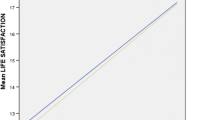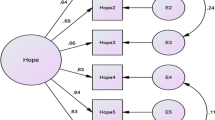Abstract
The aim of present study was to investigate the role of specific dimensions of perceived social support from family, gender, and geographic area of residence in predicting hope levels of high school students. Additionally, the factor structure of Turkish Version of the Hope Scale was reexamined due to controversial findings in Turkish literature. The sample was composed of 737 students (407 female, 330 male) from two high schools in rural and urban areas of Ankara, Turkey. Data were collected by administering the Hope Scale (Snyder et al. in J Pers Soc Psychol 60:570–585, 1991), the Perceived Social Support from Family Questionnaire (Güngör 1996), and a demographic information form. The role of independent variables in prediction of hope was investigated via Multiple Regression Analysis. Due to presence of some suppressor variables in the full model, two separate regression analyses were conducted for rural and urban areas. In the regression analysis for rural area students, informational support was the only predictor of hope levels. On the other hand, urban area students’ hope levels were predicted by love- and esteem-related support, instrumental support, and gender. Lastly, the factor structure of Turkish Version of the Hope Scale was examined through conducting a Confirmatory Factor Analysis (CFA) to test how well two-factor model fit to current data. Results of the CFA indicated that two-factor model was confirmed.
Similar content being viewed by others
References
Adelabu, D. H. (2008). Future time perspective, hope, and ethnic identity among African American adolescents. Urban Education, 43, 347–360. doi:310.1177/0042085907311806.
Akman, Y., & Korkut, F. (1993). Hope ölçeği üzerine bir çalışma [A study on hope scale]. Hacettepe Üniversitesi Eğitim Fakültesi Dergisi [Hacettepe University Journal of Education], 9, 193–202.
Atik, G. (2009). Zorbalığı yordayıcı bir değişken olarak umut [Hope as a predictor of bullying]. Ankara Üniversitesi Eğitim Bilimleri Fakültesi Dergisi [Ankara University Journal of Faculty of Educational Sciences], 42, 53–68. doi: 10.1501/Egifak_0000001137.
Atik, G., Çayırdağ, N., Demirli, A., Kayacan, N., & Çapa Aydın, Y. (2008, October). Hope and perceived support as predictors of academic self-efficacy among graduate students. Poster session presented at the 11th International Conference Further Education in the Balkan Countries, Konya, Turkey.
Atik, G., & Erkan, Z. (2009, September). Academic self-efficacy and problem solving as predictors of hope levels of Turkish high school students. Paper presented at the European Conference on Educational Research, Vienna, Austria.
Atik, G., & Kemer, G. (2009). Çocuklarda Umut Ölçeği’nin psikometrik özellikleri: Geçerlik ve güvenirlik çalışması [Psychometric properties of Children’s Hope Scale: Validity and reliability study]. Elementary Education Online, 8, 379–390.
Aycicegi-Dinn, A., & Kagitcibasi, C. (2010). The value of children for parents in the minds of emerging adults. Cross-Cultural Research, 44(2), 174–205. doi:10.1177/1069397109358389.
Bailey, T. C., & Snyder, C. R. (2007). Satisfaction with life and hope: A look at age and marital status. The Psychological Record, 57, 233–240.
Barnum, D. D., Snyder, C. R., Rapoff, M. A., Mani, M. M., & Thompson, R. (1998). Hope and social support in the psychological adjustment of children who have survived burn injuries and their matched controls. Children’s Health Care, 27, 15–30. doi:10.1207/s15326888chc2701.
Carvajal, S. C., Evans, R. I., Nash, S. G., & Getz, J. G. (2002). Global positive expectancies of the self and adolescents’ substance use avoidance: Testing a social influence mediational model. Journal of Personality, 70, 422–442. doi:10.1111/1467-6494.05010.
Çileli, M. (2000). Change in value orientations of Turkish youth from 1989 to 1995. The Journal of Psychology: Interdisciplinary and Applied, 134(3), 297–305. doi:10.1080/00223980009600869.
Crothers, M. K., Tomter, H. D., & Garske, J. P. (2005). The relationships between satisfactions with social support, affect balance, and hope in cancer patients. Journal of Psychosocial Oncology, 23(4), 103–118. doi:10.1300/J077v23n04_06.
Curry, L. A., Snyder, C. R., Cook, D. L., Ruby, B. C., & Rehm, M. (1997). Role of hope in academic and sport achievement. Journal of Personality and Social Psychology, 73, 1257–1267. doi:10.1037/0022-3514.73.6.1257.
Denizli, S. (2004). The role of hope and study skills in predicting test-anxiety levels of university students (Unpublished master’s thesis). Ankara, Turkey: Middle East Technical University.
Gariglietti, K. P., McDermott, D., Gingerich, K., & Hastings, S. (1997). Hope and its relationship to self-efficacy in adolescent girls. (ERIC Document Reproduction Service No ED 412416).
Güngör, D. (1996). Turkish university students’ relationships with their friends and families: Social support, satisfaction, and loneliness (Unpublished master’s thesis). Ankara, Turkey: Middle East Technical University.
Hagen, K. A., Myers, B. J., & Mackintosh, V. H. (2005). Hope, social support, and behavioral problems in at-risk children. American Journal of Orthopsychiatry, 75, 211–219. doi:10.1037/0002-9432.75.2.211.
Imamoğlu, E. O. (2003). Individuation and relatedness: Not opposing but distinct and complementary. Genetic, Social, and General Psychology Monographs, 129, 367–402.
Imamoğlu, E. O., & Imamoğlu, V. (1992). Life situations and attitudes of the Turkish elderly toward institutional living within a cross-cultural perspective. Journal of Gerontology: Psychological Sciences, 47, 102–108.
Imamoğlu, E. O., & Karakitapoğlu-Aygün, Z. (1999). 1970lerden 1990lara değerler: Üniversite düzeyinde gözlenen zaman, kuşak ve cinsiyet farklılıkları [Value preferences from 1970s to 1990s: Cohort, generation and gender differences at a Turkish university]. Türk Psikoloji Dergisi, 14(44), 1–22.
Imamoğlu, E. O., & Karakitapoğlu-Aygün, Z. (2007). Relatedness of identities and emotional closeness with parents across and within cultures. Asian Journal of Social Psychology, 10, 145–161. doi:10.1111/j.1467-839X.2007.00221.x.
Irving, L. M., Telfer, L., & Blake, D. D. (1997). Hope, coping, and social support in combat-related posttraumatic stress disorder. Journal of Traumatic Stress, 10, 465–479. doi:10.1023/A:1024897406135.
Kagitcibasi, C. (1992). Research in child development, parenting and the family in a cross-cultural perspective. In M. R. Rozenzweig (Ed.), International psychological science: Progress, problems and prospects (pp. 137–160). Washington, DC: American Psychological Association.
Kagitcibasi, C., & Ataca, B. (2005). Value of children and family change: A three-decade portrait from Turkey. Applied Psychology: An International Review, 54(3), 317–337. doi:10.1111/j.1464-0597.2005.00213.x.
Karakitapoğlu Aygün, Z., & Imamoğlu, E. O. (2002). Value domains of Turkish adults and university students. The Journal of Social Psychology, 142, 333–351. doi:10.1080/00224540209603903.
Kemer, G. (2006). The role of self-efficacy, hope, and anxiety in predicting university entrance examination scores of 11th grade students (Unpublished master’s thesis). Middle East Technical University, Ankara, Turkey.
Magaletta, P. R., & Oliver, J. M. (1999). The hope construct, will, and ways: Their relations with self-efficacy, optimism, and general well-being. Journal of Clinical Psychology, 55, 539–551. doi:10.1002/(SICI)1097-4679(199905)55:5<539:AID-JCLP2>3.0.CO;2-G.
Mocan-Aydın, G. (2000). Western models of counseling and psychotherapy within Turkey: Crossing cultural boundaries. Counseling Psychologist, 28(2), 281–298. doi:10.1177/0011000000282007.
Snyder, C. R. (1995). Conceptualizing, measuring, and nurturing hope. Journal of Counseling & Development, 73, 355–360.
Snyder, C. R. (2002). Hope theory: Rainbows in the mind. Psychological Inquiry, 13, 249–275. doi:10.1207/S15327965PLI1304.
Snyder, C. R., Cheavens, J., & Sympson, S. C. (1997a). Hope: An individual motive for social commerce. Group Dynamics: Theory, Research, and Practice, 1, 107–118. doi:10.1037/1089-2699.1.2.107.
Snyder, C. R., Feldman, D. B., Shorey, H. S., & Rand, K. L. (2002). Hopeful choices: A school counselor’s guide to hope theory. Professional School Counseling, 5, 298–307.
Snyder, C. R., Harris, C., Anderson, J. R., Holleran, S. A., Irving, L. M., Sigmon, S. T., et al. (1991). The will and the ways: Development and validation of an individual-differences measure of hope. Journal of Personality and Social Psychology, 60, 570–585. doi:10.1037/0022-3514.60.4.570.
Snyder, C. R., Hoza, B., Pelham, W. E., Rapoff, M., Ware, L., Danovsky, M., et al. (1997b). The development and validation of the Children’s Hope Scale. Journal of Pediatric Psychology, 22, 399–421. doi:10.1093/jpepsy/22.3.399.
Snyder, C. R., Sympson, S. C., Ybasco, F. C., Borders, T. F., Babyak, M. A., & Higgins, R. L. (1996). Development and validation of the State Hope Scale. Journal of Personality and Social Psychology, 70, 321–335. doi:10.1037/0022-3514.70.2.321.
Yadav, S. (2010). Perceived social support, hope, and quality of life of persons living with HIV/AIDS: A case study from Nepal. Quality of Life Research, 19, 157–166. doi:10.1007/s11136-009-9574-z.
Author information
Authors and Affiliations
Corresponding author
Rights and permissions
About this article
Cite this article
Kemer, G., Atik, G. Hope and Social Support in High School Students from Urban and Rural Areas of Ankara, Turkey. J Happiness Stud 13, 901–911 (2012). https://doi.org/10.1007/s10902-011-9297-z
Published:
Issue Date:
DOI: https://doi.org/10.1007/s10902-011-9297-z




